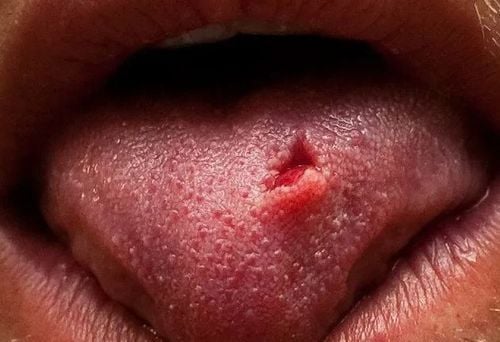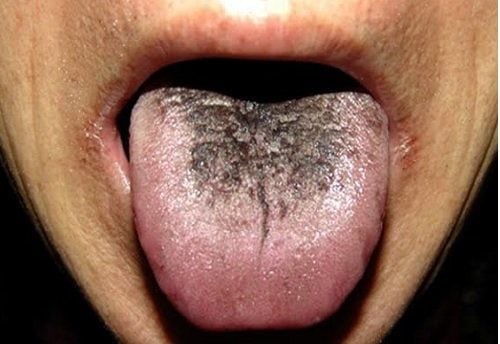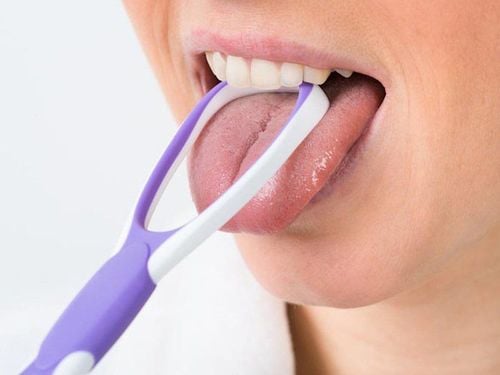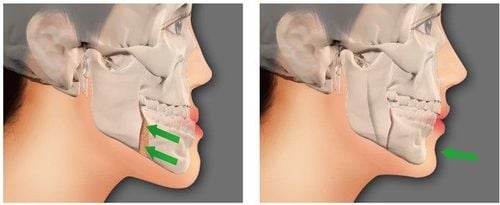This is an automatically translated article.
Tongue problems like ulcers, discoloration, sore tongue or bumps etc. can sometimes be harmless but other times, they can be an indicator of your overall health. Learn about your tongue problems in the article below to know when you should see a doctor.
1. Tongue Problems: Tongue Ulcers and Pain
1.1. What is a tongue problem? Tongue problems range from pain to changes in color and texture, and can have many different causes.
Although often hailed as "the strongest muscle in the body," the tongue is made up of a group of muscles that allow us to taste food, swallow, and speak. The tongue of a healthy person is usually pink and covered with small nodules, called papillomas. Since you use your tongue all the time, tongue problems can be frustrating and annoying.
1.2. Symptoms of Tongue Problems Different causes of tongue problems have different symptoms including:
Tongue pain Burning sensation Tongue sores Color change, from white to black Change in results structure 1.3. Causes of Tongue Problems There are many causes of common tongue symptoms. Most tongue problems are not serious and most can be resolved quickly.
However, in some cases, a discolored or painful tongue can indicate a more serious condition, including a vitamin deficiency, AIDS, or oral cancer. It is important to seek advice from your doctor if you have any ongoing problems with your tongue.
Causes of tongue sores, sores, or swelling of the tongue There are many causes that can cause your tongue to hurt or form painful bumps, including:
Injury: Accidentally biting your tongue or touching something That heat can make your tongue sore until the wound heals. Teeth grinding can also lead to irritation on the sides of the tongue and make it painful. Smoking: Smoking too much can irritate your tongue and make it painful. Canker sores: Many people will get these mouth sores on their tongue at some point. The cause is unknown, but they can be worse during periods of high stress. Burning Tongue Syndrome: Some postmenopausal women develop this syndrome, which causes the tongue to feel like it's burned. Enlarged papilla: If one or more of your taste buds becomes inflamed or irritated, it can swell and form a painful bump on your tongue. Other medical problems: Diabetes and anemia,.. can have sore tongue as a symptom. Oral cancer: Although most tongue pain is nothing to worry about, you should consult your doctor if you have a lump or sore on your tongue that doesn't go away in about a day or so. two weeks. Oral cancer is painless in its early stages, so don't assume that there's nothing wrong with not feeling pain.

Việc vô tình cắn vào lưỡi có thể gây tổn thương là nguyên nhân gây đau lưỡi
1.4. Treatment of Tongue Ulcers and Tongue Problems Treatments for sore tongue and sore tongue problems vary depending on their cause.
Your doctor may recommend a wash or gel. If you have oral thrush, you may need to take an antifungal medication. If you have sores or other conditions that cause pain, you can avoid eating spicy or acidic foods.
Cancer treatment can range from surgery to radiation and chemotherapy or drug therapy.
Since some tongue problems can be linked to poor oral health, it's important to take care of your teeth. Brush and floss regularly and use a tongue scraper to remove bacteria and other particles. If you are a smoker, talk to your doctor about quitting.
2. Tongue color change and other changes
The papillae of the tongue (tiny circles) can become discolored if a person smokes or chews tobacco, eats certain foods or vitamins, or has colored bacteria growing on the tongue.
Black discoloration on the tip of the tongue can occur if a person takes bismuth preparations for colic. Brushing your tongue with a toothbrush or scraping it off with a tongue scraper can remove such discoloration.
Pale and smooth tongue can be caused by iron deficiency anemia or pernicious anemia, which is caused by vitamin B12 deficiency.
A strawberry-red tongue can be the first sign of scarlet fever or in young children, and a sign of Kawasaki disease.
A slick red tongue and sore mouth can be a sign of general inflammation of the tongue (glossitis) or pellagra, a type of malnutrition caused by a lack of niacin (vitamin B3) in the diet.
Some areas of the tongue are red and smooth (like sores), often surrounded by a white border. Other areas, which appear white or yellow and rough, may resemble psoriasis or be caused by psoriasis. Areas of discoloration typically move over a period of weeks to years. This condition is usually painless and does not require treatment. If people have symptoms, applying low doses of corticosteroids can sometimes help.
In tongue with fissures, deep grooves are located on the surface of the tongue. The cause is unknown, but cracked tongue can occur with geographic tongue and a number of other disorders. Usually, there are no symptoms and no treatment is needed.
On the "hairy" tongue, keratin (a body protein normally found in hair, skin, and nails) accumulates on the normal projections on the tip of the tongue (papillary) and gives it a hairy appearance. A hairy tongue can develop when food particles get trapped in the tooth papillae when people do not practice adequate oral hygiene. The tongue can also become hairy after a fever, after treatment with antibiotics, or when using peroxide mouthwashes too often.
These "hairs" on the tip of the tongue should not be confused with hairy leukoplakia. Hairy leukoplakia are hairy white patches on one side of the tongue caused by the Epstein-Barr virus. It often occurs in people with weakened immune systems, especially HIV infection.

Lưỡi đổi màu có thể xảy ra ở một số tình trạng bệnh lý
White patches on the tongue, similar to those sometimes found on the inside of the cheeks, can be caused by:
Fever Dehydration Second stage of syphilis Thrush (candidiasis) Lichen planus (a pruritus can also affect the mouth) Leukoplakia (a flat white spot that develops as a result of prolonged irritation) Sharp tooth edge rubbing or broken fillings Dentistry - Jaw - Facial - General Hospital Vinmec International Department specializes in examining and treating all common dental problems in adults and children. The hospital has a team of qualified doctors and dentists and a system of advanced machinery to help support the examination process well and shorten the time.
Therefore, when there is any problem, you can go to the hospital to be checked for appropriate instructions from a specialist doctor. Avoiding leaving for a long time will affect the structure and aesthetics of the teeth.
Please dial HOTLINE for more information or register for an appointment HERE. Download MyVinmec app to make appointments faster and to manage your bookings easily.
Reference source: webmd.com











